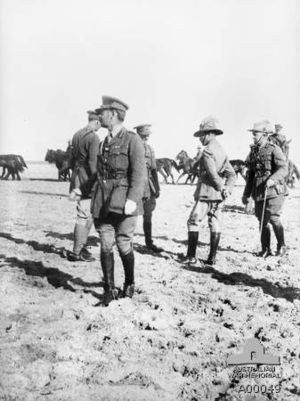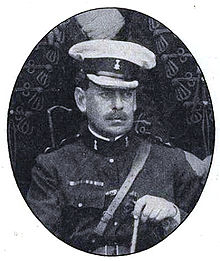- Philip Chetwode, 1st Baron Chetwode
-
The Lord Chetwode 
Chetwode (foreground) at El Arish, Egypt, January 1917Born 21 September 1869
Westminster, London, EnglandDied 6 July 1950 (aged 80)
Marylebone, London, EnglandAllegiance  United Kingdom
United KingdomService/branch British Army Years of service 1889–1935 Rank Field Marshal Commands held Commander-in-Chief, India
Chief of General Staff in India
XX Corps
Desert ColumnBattles/wars - Western Front
- First Battle of the Marne
- First Battle of the Aisne
- Second Battle of Ypres
- First Battle of Gaza
- Second Battle of Gaza
- Third Battle of Gaza
- Battle of Jerusalem
- Battle of Megiddo
Awards Knight Grand Cross of the Order of the Bath
Order of Merit
Knight Grand Cross of the Order of the Star of India
Knight Commander of the Order of St Michael and St George
Distinguished Service OrderOther work Constable of the Tower
President of the Royal Geographical SocietyField Marshal Philip Walhouse Chetwode, 1st Baron Chetwode, 7th Baronet of Oakley, GCB, OM, GCSI, KCMG, DSO (21 September 1869 – 6 July 1950) was a British cavalry officer who became Commander in Chief in India.
Contents
Early life and education
Chetwode was the son of Sir George Chetwode, 6th Baronet, and Alice Jane Bass daughter of Michael Thomas Bass the brewer. He was educated at Eton, where he was an athlete of some distinction, and entered the army through the Militia with his first commission being in the 3rd battalion the Oxfordshire and Buckinghamshire Light Infantry. He then received a regular commission with the 19th Hussars in 1889,[1] giving him early acquaintance with both light infantry and cavalry.
War service
Chetwode first saw active service in the Chinwir Hills expedition in Burma from 1892 to 1893[1] and later in the Second Boer War[1] where he took part in the defence of Ladysmith. In 1906, he became assistant military secretary to Sir John French and in 1908 was given command of a regiment in a cavalry brigade under the command of Edmund Allenby. In World War I, he served on the Western Front in smaller cavalry commands with little distinction. His 5th Cavalry brigade[1] helped cover the retreat from the frontier, and checked the pursuing Germans at Cerizy. Later in the First Battle of the Marne, Chetwode's Brigade joined with Sir Hubert Gough to become the 2nd Cavalry division.[1] Gough had been behind the Curragh incident of March 1914 and Chetwode's willingness replace him on his temporary resignation had caused some ill feeling. During this phase, there was some criticism of Sir Philip's caution in pursuit. After the British Army was held at the First Battle of the Aisne, Chetwode went up to Flanders and took part in the Second Battle of Ypres. With the war in Europe become bogged down in trench warfare, Chetwode was lucky to be transferred to the near East in December 1916 commanding the Desert Column[1] in the Egyptian Expeditionary Force under Sir Archibald Murray. In 1917 he commanded a Cavalry Division at the First Battle of Gaza and the Second Battle of Gaza.
When Edmund Allenby took command of the Allied forces in Palestine, Chetwode was promoted to command of XX Corps.[1] He led the corps with distinction at the Third Battle of Gaza. He led the main attack at the Battle of Jerusalem,[1] capturing the city after one day of fighting. The next year he again led his corps with distinction at the Battle of Megiddo.
He was portrayed in the film Lawrence of Arabia, albeit very briefly, by John Robinson, during the British staff officers' meeting in Syria. (The character is not specifically named as Chetwode, but he is an infantry general named "Philip.")[citation needed]
Service in India and after
After the war Chetwode had a number of staff appointments serving as Military Secretary from 1919,[1] Deputy Chief of the Imperial General Staff from 1920,[1] Adjutant-General to the Forces from 1922[1] and Commander in Chief Aldershot Command from 1923.[1] He was promoted to General in 1926. In 1927 he became Chief of General Staff in India[1] and in 1930 was appointed Commander-in-Chief, India.[1] He was promoted to field marshal in 1933. He was much concerned with the modernisation and "Indianisation" of the army in India. The main building and its central hall at the Indian Military Academy is named after him. The credo of the Academy, engraved on the entrance to the central hall, is a passage from his address delivered at the formal inauguration of the Academy in 1932 - "The safety, honour and welfare of your country come first, always and every time. The honour, welfare and comfort of the men you command come next. Your own ease, comfort and safety come last, always and every time." This is known as the "Chetwode Motto" and is the motto of the officers passing out from the IMA.
He returned from India, in 1936. He received the OM and an Honorary DCL at Oxford the same year. His other awards included the Croix de Guerre, Order of the Nile 2nd Class, Order of the Sacred Treasure 1st Class and other foreign orders. He was Constable of the Tower from 1943 to 1948 and was Commander of the Legion of Honour. He was also President of the Royal Geographical Society.
In his tenure as Commander-in-Chief, India, Chetwode was an opponent of replacing horses with tanks; he "made the surprising pronouncement that the Army in India would be unlikely to adopt tanks for a very long time, and then only to keep up the momentum of horsed cavalry."[2]
Family
He married Hester (Star) Alice Camilla Stapleton Cotton and had a son and daughter. Their daughter, Penelope married John Betjeman the poet (later Poet Laureate) and had a son Paul and daughter Candida Lycett Green. Chetwode's sister Florence was married to General Birch.
Honours and awards
- British
- Knight Grand Cross of the Order of the Bath (1929)
- Member of the Order of Merit (1936)
- Knight Grand Commander of the Order of the Star of India (1930)
- Commander of the Order of St Michael and St George (1917)
- Knight Commander Order of the Bath (1918)
- Distinguished Service Order (1900)
- Honorary DCL from Oxford University
- Foreign
- Croix de guerre 1914–1918 (France)
- Order of the Nile, 2nd class (Egypt)
- Silver Cross of the Virtuti Militari (Poland, 15 February 1942)
- Order of the Sacred Treasure, 1st class (Japan)
- Commander of the Legion of Honour (France)
Styles
- 1869-1889: Philip Walhouse Chetwode
- 1889-1893: Second Lieutenant Philip Walhouse Chetwode
- 1893-1897: Lieutenant Philip Walhouse Chetwode
- 1897-1901: Captain Philip Walhouse Chetwode
- 1901-1902: Captain Philip Walhouse Chetwode, DSO
- 1902-1905: Major Philip Walhouse Chetwode, DSO
- 1905-1908: Major Sir Philip Walhouse Chetwode, Bt, DSO
- 1908-1912: Lieutenant-Colonel Sir Philip Walhouse Chetwode, Bt, DSO
- 1912-1914: Colonel Sir Philip Walhouse Chetwode, Bt, DSO
- 1914-18 February 1915: Colonel (Temp. Brigadier) Sir Philip Walhouse Chetwode, Bt, DSO
- 18 February-15 July 1915: Colonel (Temp. Brigadier) Sir Philip Walhouse Chetwode, Bt, CB, DSO
- 15 July 1915-1916: Colonel (Temp. Major-General) Sir Philip Walhouse Chetwode, Bt, CB, DSO
- 1916-1917: Major-General (Temp. Lieutenant-General) Sir Philip Walhouse Chetwode, Bt, CB, DSO
- 1917-1918: Major-General (Temp. Lieutenant-General) Sir Philip Walhouse Chetwode, Bt, KCMG, CB, DSO
- 1918-1919: Major-General (Temp. Lieutenant-General) Sir Philip Walhouse Chetwode, Bt, KCB, KCMG, DSO
- 1919-1926: Lieutenant-General Sir Philip Walhouse Chetwode, Bt, KCB, KCMG, DSO
- 1926-1929: General Sir Philip Walhouse Chetwode, Bt, KCB, KCMG, DSO
- 1929-1933: General Sir Philip Walhouse Chetwode, Bt, GCB, KCMG, DSO
- 1933-1934: Field Marshal Sir Philip Walhouse Chetwode, Bt, GCB, KCMG, DSO
- 1934-1936: Field Marshal Sir Philip Walhouse Chetwode, Bt, GCB, GCSI, KCMG, DSO
- 1936-1945: Field Marshal Sir Philip Walhouse Chetwode, Bt, GCB, OM, GCSI, KCMG, DSO
- 1945-1950: Field Marshal the Right Honourable the Lord Chetwode, Bt, GCB, OM, GCSI, KCMG, DSO
References
External links
Military offices Preceded by
New PostGeneral Officer Commanding XX Corps
1917–1918Succeeded by
Post DisbandedPreceded by
Sir Francis DaviesMilitary Secretary
1919–1920Succeeded by
Sir Alexander GodleyPreceded by
Sir Charles HaringtonDeputy Chief of the Imperial General Staff
1920–1922Succeeded by
Post disbandedPreceded by
Sir George MacdonoghAdjutant General
1922–1923Succeeded by
Sir Robert WhighamPreceded by
Sir Thomas MorlandGOC-in-C Aldershot Command
1923–1927Succeeded by
Sir David CampbellPreceded by
Sir William RobertsonColonel of the Royal Scots Greys
1925–1947Succeeded by
George ToddPreceded by
The Lord BirdwoodCommander-in-Chief, India
1930–1935Succeeded by
Sir Robert CasselsHonorary titles Preceded by
Sir Claude JacobConstable of the Tower of London
1943–1948Succeeded by
The Earl WavellPeerage of the United Kingdom New creation Baron Chetwode
1945–1950Succeeded by
Philip ChetwodeBaronetage of England Preceded by
George ChetwodeBaronet
(of Oakley)
1905–1950Succeeded by
Philip Chetwode20th century George Taubman Goldie · Leonard Darwin · George Curzon, 1st Marquess Curzon of Kedleston · Douglas Freshfield · Thomas Holdich · Francis Younghusband · Lawrence Dundas, Earl of Ronaldshay · David George Hogarth · Charles Close · William Goodenough · Percy Zachariah Cox · Henry Balfour · Philip Chetwode, 1st Baron Chetwode · George Clark · Francis Rodd, 2nd Baron Rennell · Harry Lindsay · James Wordie · James Marshall-Cornwall · Roger Nathan, 2nd Baron Nathan · Raymond Priestley · Dudley Stamp · Gilbert Laithwaite · Edmund Irving · Edward Shackleton, Baron Shackleton · Duncan Cumming · John Hunt, Baron Hunt · Michael Wise · Vivian Fuchs · George Bishop · Roger Chorley, 2nd Baron Chorley · Crispin Tickell · George Jellicoe, 2nd Earl Jellicoe · John Palmer, 4th Earl of Selborne
21st century Categories:- Presidents of the Royal Geographical Society
- British Field Marshals
- British Commander-in-Chiefs of India
- British Army personnel of the Second Boer War
- British Army World War I generals
- 19th Royal Hussars officers
- Royal Scots Greys officers
- Members of the Order of Merit
- Bailiffs Grand Cross of the Order of St John
- Barons in the Peerage of the United Kingdom
- Knights Commander of the Order of St Michael and St George
- Knights Grand Cross of the Order of the Bath
- Knights Grand Commander of the Order of the Star of India
- Commandeurs of the Légion d'honneur
- Companions of the Distinguished Service Order
- Recipients of the Croix de Guerre (France)
- Grand Officers of the Order of the Nile
- Silver Crosses of the Virtuti Militari
- Recipients of the Order of the Sacred Treasure, 1st class
- 1869 births
- 1950 deaths
- People from Westminster
Wikimedia Foundation. 2010.

